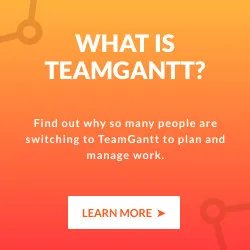What is an OKR? Meaning, Examples, & Template
.webp)
.webp)



Effective project managers have evolved from simply managing workforces and timelines to aligning projects, people, and resources with successful outcomes.
As a project manager, you’ve got a lot of moving pieces to manage while simultaneously looking forward to future projects. You may have wondered how big-name organizations like Alphabet, Amazon, and Samsung can effectively sustain their growth over time.
The answer? OKRs.
Before I get ahead of myself, let's start with the basics: What does OKR stand for?
What is an OKR?
OKR is an acronym that stands for objectives and key results. OKRs align employees with company goals using measurable outcomes. This framework differs from other goal-setting techniques by pushing individuals out of their comfort zone to achieve success beyond what they thought was possible.
With OKRs, each objective is supported by a set of key results. Key results are the outcomes you need to achieve to accomplish your objective. Each key result will point to projects and tasks—or initiatives—that can help you maximize your key results and get closer to reaching your objective.
Why are OKRs important?
Knowing where you want to go is no use unless you also know how to get there. OKRs align your projects and strategies with company goals so your team has a clear roadmap towards success.
The OKRs you set to build your company culture and provide employees with meaningful tasks give purpose to even menial everyday activities.
The OKR framework: Defining objectives and key results
To understand how establishing an OKR framework can help you reach your goals, you must first understand the difference between OKR objectives and key results.
OKR objectives
OKR objectives are the main goals of an organization. These are the big ones—the long-term goals that require continuous engagement and tenacity over several months or more to see positive results. Imagine your objective as the capstone of the OKR pyramid, and the bricks supporting it are your key results.
OKR key results
OKR key results are the outcomes that measure your progress toward the objective. Tracking your key results helps your team meet lofty goals incrementally over time. To get to the top of the pyramid, you must first achieve your key results.
OKR vs. KPI: What’s the difference?
At first glance, OKRs seem similar to their cousins, KPIs (aka: key performance indicators). The main difference between an OKR and a KPI is that key performance indicators give a snapshot of how your business is currently operating toward your goals. In contrast, objectives and key results are defined more broadly and focus on an organization’s future.
This chart provides a quick comparison of OKRs vs KPIs.
A brief history of the OKR methodology
The OKR framework traces its origins to Intel, where Andy Grove introduced the method for goal-setting. At the time, Intel was about to shift towards microprocessing and needed a new way to help employees focus on their goals to transition successfully.
At Intel, John Doerr learned how OKRs could help communicate business priorities and maintain long-term alignment. He then took this knowledge with him as an early investor for Google. After introducing Google’s leadership to the OKR method, they began using OKRs for their quarterly and annual goals—and still do to this day.
Since Google started implementing OKR methodology in early 2000, companies in other sectors have taken notice and adopted this goal-setting framework to achieve the same levels of success and innovation. Companies like Anheuser-Busch, Panasonic, and Viacom use OKR methodology to take their companies to the next level year after year.
What are the benefits of OKRs?
Let’s talk about some of the reasons why you might use OKRs. Setting company-wide objectives and key results not only helps teams maintain focus throughout the year. It also unifies organizations so they can accomplish more together on the way to their common goal.
Businesses that clarify organizational goals and set specific, measurable OKRs can achieve more than companies that use other goal-setting methods. Here are just a few benefits that come with setting organizational OKRs:
- Alignment: When managers and employees use OKRs to align teams in a common direction across departments, everyone in the organization is poised to build momentum towards reaching aggressive goals.
- Productivity: Communicating goals with objectives and key results ensures everyone knows their expectations and gives them a roadmap to achieve milestones on the way to more significant organizational objectives.
- Culture: Deploying a goal management system like OKRs can cause a shift from output to outcome-focused evaluation. Instead of simply measuring sales or revenue, OKRs help organizations base success on increased performance and positive business outcomes.
- Execution: The OKR method creates a laser beam of focus that cuts through the noise so employees and team leaders can prioritize work directly linked to your objectives.
- Engagement: When employees have a purpose, they thrive. It’s easier for employees to connect their projects with big-picture objectives. OKRs boost team productivity and happiness and allow employees to see themselves as an integral part of your organization.
How to write measurable OKRs
Now you know what OKRs are and how they can benefit your organization. But how do you write good OKRs you can actually measure? Use this simple formula as a template to create OKRs for any application:
“I will [objective] as measured by [key result].”
Setting OKRs follows a strategic and straightforward method that involves asking yourself a few questions about your company goals. These 3 questions can help you discover what your objective is and which key results to work toward on the way.
1. Where do you want your organization to go?
The answer to this question is your objective. Maybe you want to increase revenue since last quarter, improve the customer experience, or become an innovator in your sector. Don’t be afraid to dream big here.
Your objectives should be lofty enough to inspire drive without being so out of reach no one else can see your vision.
2. How will you know you’re working on the right path towards your objectives?
The answer to this question will reveal what your key results are. If the objective is your destination, then the key results are the signposts that tell you how much further you have to go before you arrive at your objective.
For example, suppose your goal is to beat last quarter’s earnings. In that case, your key results might include decreasing your sales cycle, increasing sales to existing customers by 20%, or generating $500,000 in a new region.
3. What do you have to do to get there?
The answer to this question will tell you what your initiatives should be to achieve your key results and, over time, realize your primary objectives. Initiatives are the projects, tasks, and other work you should prioritize to bring your results to life.
If one of your key results is to upsell more existing customers, then your initiatives might include segmentation for triggered marketing emails or implementing a rewards program. Your initiatives should be specific, measurable, and attainable stepping stones that lead to your key results and, ultimately, your objectives.
Common OKR pitfalls to avoid
Project managers know planning is essential to success, and that applies to OKRs too. OKRs should be fully understood by your team and have a metric that can be measured.
Looking out for these common OKR pitfalls can help ensure you set solid OKRs:
- Your objectives are either too challenging or not challenging enough. A reasonable OKR success rate is about 70%. Shooting for below 90% ensures that your goals stretch your team's abilities without disempowering them or being unrealistic.
- You set too many OKRs. Too many objectives or key results can dilute productivity and spread people and resources. Aim to develop 1-3 main objectives per quarter with 3-5 key results for each objective so your employees can stay focused on organizational directives.
- Your key results are hard to measure. Choose key results that have a numeric or quantitative value so it’s easy to tell if your team’s on the right track or not.
- You don’t communicate regularly about OKRs. Avoid setting OKRs that aren’t impactful enough to be revisited weekly. Teams should take time to discuss where they stand with their OKRs and work together to discover their next steps.
Simple OKR examples
The best thing about OKR methodology is you can implement it no matter what sector your business operates within. OKRs work at both a high and a granular level—and every point in between.
Here are some simple OKR examples you can use as a jumping-off point for setting your own OKRs:
Free OKR template: Set and measure goals in TeamGantt
OKRs are a perfect fit for TeamGantt because every project detail is measurable. This free OKR template is formatted with objectives listed as task groups and each key result recorded as a task below its related objective. All you have to do is update the task names and delete any extra items you don’t need.
Try our OKR planning template for free!

Tracking OKR metrics in TeamGantt
You can use this template as a simple scorecard for your progress toward each goal. Update your OKRs at the end of the quarter (or any point along the way), and leave comments about goals you've achieved and marks you've missed.
Progress is scored based on the duration of the tasks in the gantt chart, as well as the number of tasks in the group or project. You can view the progress of each key result under an objective to check in on team OKRs.

Sharing your OKR dashboard with your team and stakeholders
In TeamGantt, you can export a PDF of your gantt chart to share in an OKR review meeting or share a view-only link to the project so others can track progress along the way. This makes it easy to report OKR status to bosses, clients, and other key stakeholders.
Plan and track projects and goals easily with TeamGantt
Online project management software like TeamGantt not only gives you more visibility into active projects. It can also help you keep track of outcomes and align people and resources with big-picture goals.
Discover even more TeamGantt features, and see just how easy it is to plan and track OKRs so you can take your organization to the next level.
About the author
Nahla Davies is a software developer and tech writer. Before devoting her work full time to technical writing, she managed—among other intriguing things—to serve as a lead programmer at an Inc. 5,000 experiential branding organization whose clients include Samsung, Time Warner, Netflix, and Sony.